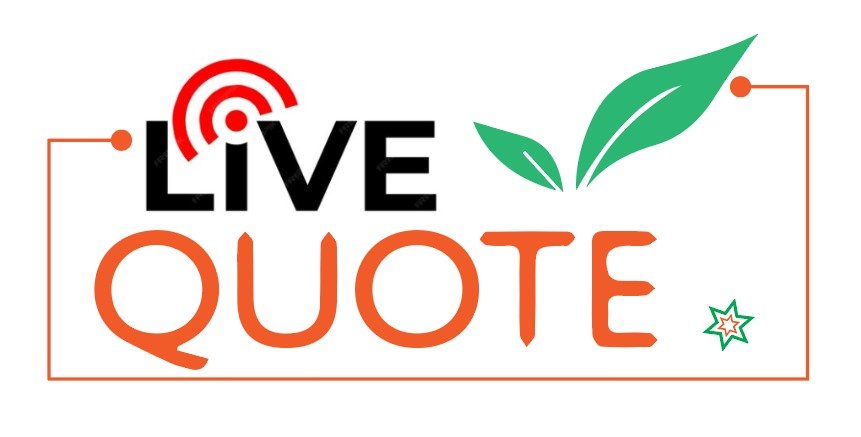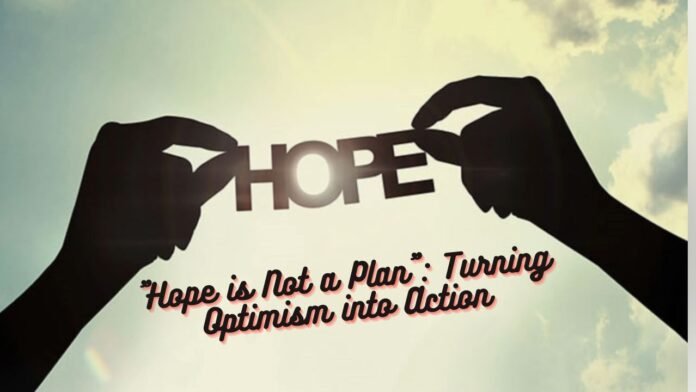The quote “hope is not a plan” is a powerful reminder that simply wishing for something doesn’t guarantee its achievement. While hope is crucial for maintaining a positive outlook and motivation, it must be paired with concrete action to turn dreams into reality.
This maxim is often used in contexts where careful planning and execution are essential, such as:
- Business: When launching a new venture or navigating challenges, hoping for success without a well-defined strategy will likely lead to disappointment.
- Personal Development: Aspiring to achieve goals like learning a new skill or improving health requires a plan that outlines specific steps and timelines.
- Leadership: Leaders who rely solely on hope to solve problems or inspire their team are unlikely to achieve lasting progress.
Hope is not a plan quote, however, it’s important to remember that “hope is not a plan” doesn’t equate to dismissing hope altogether.
Hope acts as the fuel that ignites our passions and motivates us to take action. It allows us to envision a brighter future and persevere through challenges.
Here’s how you can effectively transform hope into a driving force for achievement:
- Develop a clear plan: Define and break your goals into smaller, actionable steps.
- Identify potential obstacles: Anticipate challenges and formulate strategies to overcome them.
- Take consistent action: Regularly work towards your goals, even when faced with setbacks.
- Stay flexible: Adapt your plan if necessary, but don’t abandon it entirely.
- Celebrate progress: Acknowledge and reward yourself for every step towards your goal.
By embracing the philosophy of “hope is not a plan,” you empower yourself to turn your dreams into achievable goals. Remember, hope combined with strategic planning and consistent action is a potent recipe for success.
In a world where uncertainty is often the norm, the quote “Hope is not a plan” resonates profoundly.
This simple yet profound statement emphasizes the importance of strategic action over passive optimism. While hope can provide motivation and inspiration, relying solely on hope without a concrete plan can lead to disappointment and unfulfilled dreams.
Why Hope Alone Isn’t Sufficient
Hope is a powerful force that inspires and motivates us to pursue our dreams. It provides us with optimism and resilience, especially in challenging times. However, more than hope is needed to achieve our goals.
While hope may set the stage for success, it lacks the substance and direction necessary for tangible results. With a solid plan of action, hope can easily lead to active waiting rather than proactive steps towards our aspirations. We must complement hope with strategic planning, clear goals, and actionable steps to truly turn hope into reality.
By combining hope with proactive action, we can navigate obstacles more effectively and increase our chances of success.
Examples from History and Literature
Throughout history and literature, countless examples have shaped our understanding of the world and the human experience. These examples offer valuable insights into culture, society, and human nature from ancient to modern times.
In history, examples such as the rise and fall of empires, revolutions, and scientific discoveries illustrate the dynamic nature of human progress. Whether the fall of the Roman Empire, the French Revolution, or the Industrial Revolution, each event provides lessons that inform our present and future.
Similarly, literature offers a rich tapestry of examples that capture the complexities of the human condition. From Shakespearean tragedies to contemporary novels, literary works explore love, loss, ambition, and redemption themes.
Characters like Hamlet, Jay Gatsby, and Elizabeth Bennet are enduring symbols of universal truths and timeless dilemmas.
By studying examples from history and literature, we gain a deeper understanding of ourselves and the world around us. These examples serve as mirrors reflecting our triumphs, failures, and aspirations, guiding us as we navigate the complexities of life.
Understanding the Quote
Hope is not a plan quote, “understanding the Quote” suggests delving into the deeper meaning behind a particular statement or saying. It involves dissecting the words, context, and implications to gain insight and clarity.
Whether exploring a famous quotation, a proverb, or a line from literature, understanding the underlying message is essential for applying its wisdom. This process often requires critical thinking, empathy, and open-mindedness.
By unraveling the layers of meaning embedded within a quote, we can gain valuable perspectives, provoke thought, and foster deeper connections with ourselves and others.
The Importance of Having a Solid Plan
Having a solid plan is paramount in both personal and professional endeavors. It serves as a roadmap, guiding individuals and organizations toward their objectives. A well-crafted plan provides clarity, direction, and purpose, ensuring that efforts are focused and resources are utilized efficiently. Without a solid plan, individuals may drift aimlessly, lacking a clear vision of what they hope to achieve.
Moreover, a solid plan enables individuals to anticipate potential obstacles and devise strategies for overcoming them. A solid plan instils confidence and fosters a sense of accountability, empowering individuals to take decisive action and achieve meaningful results.
Whether embarking on a new project, pursuing a career goal, or navigating life’s challenges, having a solid plan lays the foundation for success.
The Dangers of Relying Solely on Hope
While hope can be a powerful force guiding us through challenging times, relying solely on it can have detrimental consequences. One of the primary dangers of placing all our faith in hope is that it often leads to passivity.
When individuals solely rely on hope to improve their circumstances, they may fail to take proactive steps towards achieving their goals. This passive approach can result in missed opportunities and unfulfilled potential.
Moreover, relying solely on hope can lead to disappointment and disillusionment. We set ourselves up for failure without concrete plans or actions to support our hopes. When things don’t go as expected, it can be devastating, causing us to lose faith in ourselves and our abilities.
Additionally, relying solely on hope can hinder personal growth and development. Instead of taking responsibility for our actions and pursuing our goals, we may become complacent, waiting for things to fall into place magically. This mindset can prevent us from learning from our experiences and becoming the best version of ourselves.
Strategies for Turning Hope into Action
Turning hope into action requires more than mere optimism; it demands strategic planning and deliberate steps towards your goals. One effective strategy is setting SMART (Specific, Measurable, Achievable, Relevant, Time-bound) goals, breaking your aspirations into tangible objectives.
Creating a detailed action plan with clear steps and deadlines can help translate hope into actionable tasks. Surrounding yourself with a supportive network of mentors and peers can provide guidance and accountability, further fueling your determination.
Moreover, visualization techniques, such as creating vision boards or regularly visualizing your desired outcomes, can reinforce your commitment to taking concrete steps.
Remember, hope is the spark that ignites action, but the strategies you employ ultimately determine your success.
Real-Life Examples of Embracing Planning Over Hope
Hope is not a plan, Business, countless success stories illustrate the power of strategic planning over blind hope. Take the case of Apple Inc., under the visionary leadership of Steve Jobs. Instead of merely hoping for success, Jobs meticulously planned each product launch, marketing strategy, and innovation.
This approach transformed Apple into one of the most valuable companies globally, emphasizing the importance of meticulous planning in achieving long-term objectives. Similarly, consider the achievements of Nelson Mandela in dismantling apartheid in South Africa. Mandela didn’t rely solely on hope; he developed a detailed strategy that involved negotiation, activism, and international pressure.
Through careful planning and execution, Mandela achieved what many deemed impossible, underscoring the transformative potential of strategic thinking. These real-life examples highlight the benefits of embracing planning over hope in driving meaningful change and achieving ambitious goals.
Tips for Creating Effective Plans
Creating effective plans is essential for achieving success in any endeavor. Whether tackling a personal goal or leading a team project, a well-thought-out plan provides direction and clarity. Here are some tips to help you craft effective plans:
- Set Clear Goals: Clearly define what you want to accomplish with your plan. Ensure your goals are specific, measurable, achievable, relevant, and time-bound (SMART).
- Do Your Research: Gather relevant information and data to inform your plan. Understand the challenges and opportunities associated with your goal to develop a realistic strategy.
- Break It Down: Divide your overarching goal into smaller, actionable tasks. Breaking down your plan into manageable steps makes tracking progress and staying on target easier.
- Establish Priorities: Identify and prioritize the most critical tasks based on their importance and urgency. Focus your resources and energy on activities that will have the greatest impact.
- Allocate Resources Wisely: Assess what resources (such as time, money, and workforce) are needed to execute your plan effectively. Allocate resources strategically to maximize efficiency and minimize waste.
- Create a Timeline: Set deadlines for each task to create a sense of urgency and accountability. A well-defined timeline helps you stay organized and ensures steady progress toward your goal.
- Seek Feedback: Share your plan with trusted colleagues, mentors, or stakeholders and solicit their feedback. Incorporating diverse perspectives can help identify blind spots and improve the quality of your plan.
- Be Flexible: Recognize that plans may need to be adjusted in response to unforeseen circumstances or changing priorities. Stay open to alternative approaches and be willing to adapt as needed.
By following these tips, you can create effective plans that set you up for success and guide you towards achieving your goals.
Overcoming Obstacles in the Planning Process
Hope is not a plan quote, planning is essential to achieving goals and realizing dreams. However, the planning process has challenges. From unexpected obstacles to unforeseen setbacks, navigating the path toward success can be daunting.
Yet, it’s important to remember that obstacles are not roadblocks but opportunities for growth and innovation.
One common obstacle in the planning process is a need for more clarity. More than clear goals or objectives can hinder progress and overwhelm planners. To overcome this obstacle, it’s crucial to take the time to define specific, measurable, achievable, relevant, and time-bound (SMART) goals.
Planners can gain clarity and direction by breaking down larger objectives into smaller, actionable steps.
Another challenge is resistance to change. Planning often requires individuals to step out of their comfort zones and embrace new ideas or strategies. Overcoming this obstacle requires adapting and remaining flexible in the face of uncertainty. By embracing change and viewing challenges as opportunities for growth, planners can overcome obstacles and succeed in their endeavours.
The Role of Adaptability in Executing Plans
Adaptability plays a pivotal role in the successful execution of plans. In today’s dynamic and ever-changing world, rigid adherence to a predetermined course of action can often lead to failure.
Instead, those who embrace adaptability are better equipped to navigate unforeseen challenges and capitalize on unexpected opportunities. Whether in business, education, or personal endeavours, adjusting and pivoting in response to changing circumstances is invaluable. Adaptability fosters resilience, creativity, and innovation, enabling individuals and organizations to thrive in uncertain environments.
By remaining flexible and open-minded, individuals can stay ahead of the curve and achieve their goals more easily. In essence, adaptability is not merely a desirable trait but necessary for success in today’s fast-paced world.
How to Stay Motivated While Executing Plans
Hope is not a plan quote, staying motivated while executing plans can be challenging, but it’s essential for achieving your goals. One effective strategy is to break down your plans into smaller, more manageable tasks. Celebrate each milestone you accomplish, no matter how small, to maintain a sense of progress and momentum.
Additionally, surround yourself with positive influences, such as supportive friends or mentors, who can provide encouragement and accountability. Visualize your end goal regularly to stay focused and remind yourself why you started in the first place.
Finally, remember to take care of your physical and mental well-being by getting enough rest, staying active, and practising self-care. By implementing these strategies, you can stay motivated and committed to executing your plans successfully.
Balancing Hope with Practicality
Balancing hope with practicality is a delicate art that requires optimism and realism. While hope fuels our dreams and aspirations, practicality grounds us in reality, ensuring our goals are attainable and sustainable. Striking the right balance between these two forces is essential for success.
We risk setting ourselves up for disappointment when we lean too heavily towards hope without considering practicality. Unrealistic expectations can lead to frustration and disillusionment when our dreams fail to materialize.
On the other hand, being overly practical can stifle innovation and creativity, limiting our potential for growth and fulfilment.
The key is to blend hope with practicality in a way that inspires action while accounting for the challenges and limitations we may encounter.
By setting ambitious yet achievable goals and approaching them with a pragmatic mindset, we can turn our hopes into reality while navigating the complexities of life with wisdom and grace.
Celebrating Successes and Learning from Failures
Celebrating successes and learning from failures are integral to personal and professional growth. When we achieve our goals, it’s important to take the time to acknowledge and celebrate our accomplishments. Whether big or small, each success represents a milestone in our journey toward success. Celebration boosts morale, reinforces positive behaviours, and motivates us to strive for excellence.
Similarly, failure is not the end but an opportunity for learning and improvement. We gain valuable insights to inform future decisions and actions by analyzing our mistakes and understanding what went wrong.
Embracing failure as a stepping stone toward success fosters resilience and perseverance. Every setback is a chance to grow stronger and wiser, ultimately paving the way for greater achievements in the future. So, let’s celebrate our successes and embrace our failures as valuable lessons on the path to success.
The Relationship Between Hope, Planning, and Resilience
The relationship between hope, planning, and resilience is fundamental to human perseverance and achievement. Hope is the foundation, providing optimism and belief in a better future. It ignites the desire to set goals and pursue dreams.
However, hope alone is not enough. Planning acts as the bridge between hope and reality, transforming aspirations into actionable steps. It involves setting clear objectives, devising strategies, and allocating resources effectively.
Meanwhile, resilience is the glue that holds it all together. It enables individuals to navigate setbacks, overcome obstacles, and persist in adversity. Together, hope, planning, and resilience form a powerful trio that empowers individuals to turn challenges into opportunities and dreams into reality.
Conclusion
In conclusion, while hope is a powerful motivator, it is not a substitute for strategic planning. You can turn your aspirations into reality by embracing proactive action and developing well-defined strategies. Remember, “Hope is not a plan,” but anything is possible with careful planning and perseverance.
FAQ
What does “hope is not a plan” mean?
This quote emphasizes that simply wishing for something is not enough to achieve it. While hope is important for motivation, achieving your goals requires a concrete plan and action.
Where is this quote used?
The quote is often used in business, personal development, and leadership, where success hinges on careful planning and execution.
Does “hope is not a plan” mean we should never hope?
No! Hope is a valuable tool for maintaining a positive outlook and staying motivated. However, it needs to be accompanied by action to translate dreams into reality.
How can we turn hope into action?
Develop a clear plan with defined goals and steps, anticipate challenges and develop solutions, take consistent action, be flexible and adaptable, and celebrate your progress.
What is the takeaway from “hope is not a plan”?
Embrace hope, but pair it with strategic planning and consistent effort to increase your chances of success. Wishing for something is the first step; turning it into reality requires a roadmap and the drive to follow it.


